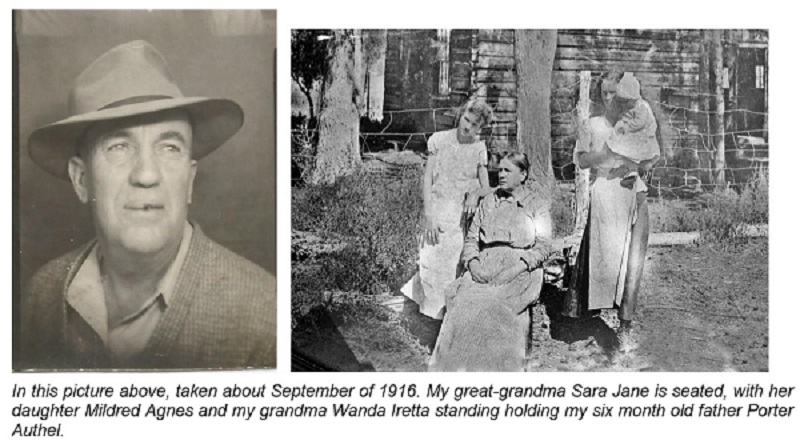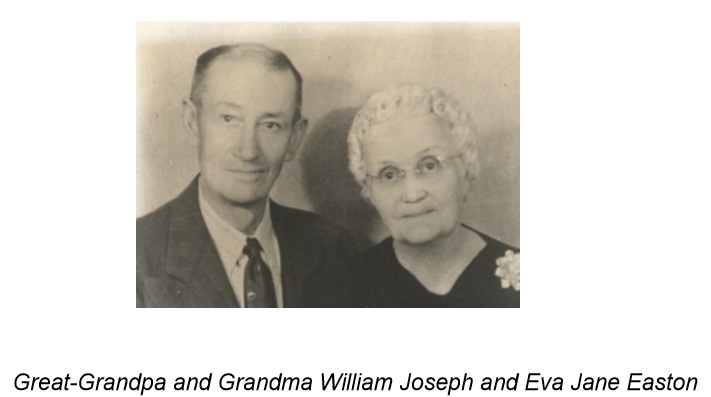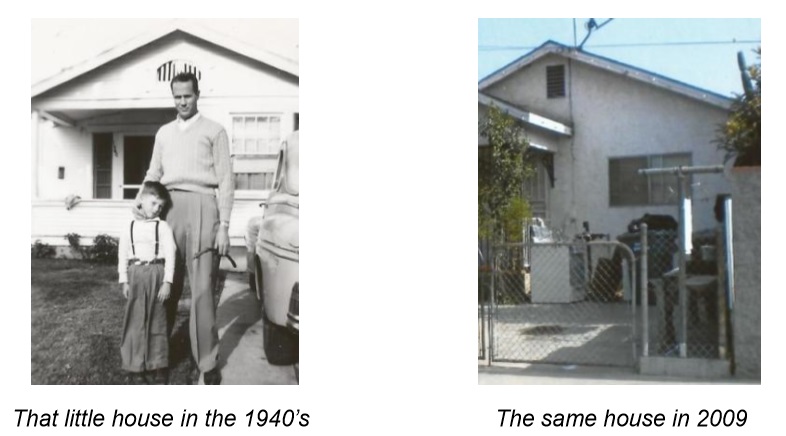Their second child was Daniel Oliver Martin, seated on his fathers right, was born March 30, 1866, in Beaver.
He was a farmer in Greenville. He was my great-grandfather. On September 4, 1887 he married my great-grandmother
Sara Jane Edwards. Daniel Oliver died March 6, 1919 and Sara Jane died March 2, 1945

My grandfather, William (Bill) Porter Martin, was the third child of 8 children of Daniel Oliver and Sara Jane.
He was known around those parts as the town drunk. His main hangouts were the Beaver Pool hall or the jail in the
basement of the courthouse. It was rumored that he had a cell with his name on it. He was a character with adventures
you could write a book about. My motherís family must have been shocked when she took up the likes of the son of
Bill Martin. He was believed to be buddies with Butch Cassidy and the Sun Dance Kid and the Hole In The Wall Gang.
My dad and the Old Man (as he referred to him) did not have a great relationship, but dad could go on for hours telling
tales of the adventures of his dad. I guess you could refer to him as a paradox. He was a character you could love and
hate at the same time It was fascinating to sit and listen to dad tell stories of growing up with the likes of this
character. Granddad was a bootlegger during Prohibition. They lived on a farm in Greenville, Utah. The Sheriff would
raid the farm looking for the sour mesh and stile he was using to make moonshine. So he would station the kids up the
lane so they could warn him when the law was coming. Dad said the Sheriff never did figure out where he hid the goods.
When dad was about twelve, he was with his dad to deliver whisky to someone at the hotel in Beaver. They had the whisky
in gallon jugs. He said when they got out of the Model T in front of the hotel, the Revenuers and the Sheriff came around
the corner on both ends of the street. Dad said he thought the jig was up. But Granddad just dropped the bottles in the
street and drove away.
When electricity came to the area and they were stringing the lines, they went to every house and asked if they wanted
to connect. The Old Man declined. He just watched them connect other folks and when they left, he climbed the pole and
connected up himself. In dadís Sophomore year in high school he got into a fight with the Old Man because he hit my
grandmother. Dad hit him with a whiskey bottle, and nearly killed him. Dad moved out and lived with grandma Easton. I
could go on and on with stories about the Old Man. That could be the subject of my next book. The fact of the matter was,
when he was sober, he was a real charmer.
On the other hand thereís the other half, my grandmother. She was a saint. How she got mixed up with the likes of my
grandfather is a total mystery. Wanda Iretta Easton was only fifteen and he was twenty-three when they were married in
1915. She was one of six children of William Joseph and Eva Jane Easton, a farmer in Beaver and my great-grandparents

Grandmother Wanda
Thell stepped up and took the lead as big brother along with his mother in the business of raising the family. Dad did
not get a chance to finish high school because he had so many responsibilities. Times were tough during the depression years
of the 1930ís.

MY EARLIEST MEMORIES My memories of my first five years are pretty vague. I remember that we lived in a brick grain and
tack storage building. It was one room about twelve feet square, with a cellar, no running water and outhouse. My dad worked
for the forest service, riding the Beaver mountains on horseback, clearing brush, building fences and keeping count of the deer
population. If the herds outgrew the feeding area, they would thin them out. The poor children in Utah would have venison
on the table. Dad and his partner Claire Rollins, had a model T- Ford flatbed pickup they used to haul supplies up to the
Beaver mountains. You had to crank the thing to get it started. Well, they were loading supplies from the cellar to the
pickup. I was probably about four and I was standing behind the pickup when Claire cranked the stupid thing to start it.
He forgot he left it in gear and it took off and ran right over me. Fortunately, I was standing right in the center between
the wheels and it knocked me down and went over me. I was wearing bib overalls, and it hooked on to the overalls and drug me
about 10 yards before they got it stopped. Dad was coming out of the cellar with a keg of nails and he threw nails all over
the yard. I was not hurt, but it was one of my early vivid memories.
In the mid 1930ís living standards in the rural areas of our country was pretty basic. There were very few houses with running
water. They had wells with a hand pump. You had a bucket of water in the house with a place to wash up. You take a bath in a
portable metal bath tub, about once a month, with water hauled in and heated on a wood burning stove. Drinking water was in a
separate bucket with a communal ladle hanging on the side. Toilet facilities, except for a very few homes was an outhouse, except
for pots under beds. Cooking was done on wood and coal burning stoves. Heating was done with fireplaces or pot-bellied stoves.
Only the main highways were oiled (paved). All the streets were dirt, or gravel, if it was a main drag. All irrigation was done
with ditches running down almost every street. You could actually catch trout in the irrigation ditches. Almost everyone had large
gardens where they raised their own produce. They also raised their own livestock such as beef, chickens and pigs. They didnít
have much, but they ate pretty well.
There was not a lot of career opportunities ln Beaver, so Porter made a life changing decision to move to California.
It was 1939 and the world was a mess. Hitler was moving across Europe. FDR was making some progress with getting people back
to work with programs like WPA, but jobs were slim picking and there were a lot of people in bread lines.
My dadís brother Bill was going with a girl named Ardella (Ardie) Farnworth, from California. The Farnsworth family was originally
from the Beaver area, but had relocated in Southern California. Bill and Ardie were fixing to get married so Bill and Dad decided to
pull up stakes and move to California. Ardie had a twin brother Odie. It turned out that the Farnsworth clan in the Temple City
area just northeast of Los Angeles, had some possible connections for jobs. I was just four years old and just vaguely remember the
excitement they were experiencing starting a new life adventure. Odie had just bought a new Chevrolet and Bill and my mom and dad and
old Ern, went sailing off to California with Odie and his new Chevrolet

As young as I was, I still have some memories of that trip. We came through Las Vegas. At that time it was just a train station and
one block town with the Golden Nugget Casino Hotel. There were a couple of Dude Ranches outside of town on the way to L.A. There was
one called El Rancho Vegas, but I donít recall the name(s) any of the others. I remember passing Search Light Nevada, because there
was a search light on the hill. In 1939 all of the land where the strip is was homestead land
We were lucky and Bill and Dad got jobs right away. I think their first jobs were as laborers. We rented a house and settled in
San Gabriel. I donít remember much about that first year, but there was food on the table and work was steady. Life was good.
THEN CAME THE 1940íS We only lived in San Gabriel for a short time after we moved to California, less than a year I believe, before
we ended up in East Los Angeles. Lund and Margret Turner, friends from Beaver, lived there and we rented a house next door to them.
Lund worked for the Union Pacific Railroad and the railroad yards were two blocks from our house. The house we rented was a little one
bedroom house at 1360 S. Marianna Ave. It was a small house built in the early 20ís. The only picture I could find is the one on the
left. Todayís version is on the right

We didnít have a refrigerator, but we had running water and inside plumbing. We had an ice man and milkman. Dad partitioned the one
bedroom to make two really tiny bedrooms. On top of that, we always had one of the family living with us from the time we moved in.
First it was Virginia (Virg to family and friends), my dadís youngest sister. She was a little wild the last couple of years in high
school in Beaver, in fact she got married on a dare after a party one night (they had it annulled the next day). Well, her big brother
decided she needed some guidance. So, he brought his little sister to California to live with us. She was really a character and we
had a lot of fun when she was with us. Our house was small and we slept together. I was six and she was eighteen or nineteen. That
was June or July of 1941. Then on December 7th of that year all hell broke loose, Japanís surprised bombing attack on Pearl Harbor got
The United States propelled into World War II. I can remember President Roosevelt coming on the radio calling this a day of infamy
and declared war on the Japanese Empire. Not long after that The United States joined England, France, Russia and the other European
allies in the war against Hitlerís Germany. The War really brought the people of this country together. Both Virg and mother went
to work in a defense plant. They were winding coils at Pioneer Electric.

This was ELAís version of how this country stepped up as Americans of all nationalities to do their part in the war effort. As an
example, my folks were born and raised in an area of our country where most people were white and Mormon. The picture on the right is
my mother and her new friend she met at the plant. Her name was Sicora Alvarez and she was Mexican. She and my mother became very close
friends. Sicora taught my mother how to make real enchiladas from scratch. The recipe started out with raw ingredients like fresh chilies
for the sauce and the tortillas as well were made fresh. You could make them with fillings of beef, chicken, pork or cheese. I remember
they would roll them together on a cookie sheet then poured that homemade sauce and cheese on top. What I remember most of all was the
aroma. We had one enchilada party with all of our family and Sicoraís family cutting tortillas together. After my mother passed away,
we searched everywhere for that recipe, but never found a trace..
As a kid, what confused me was how diversified the set of prejudices there were. I was in a perfect position to observe but not old
enough to interpret what I was seeing We had Mexican gangs here at home fighting with our police and we were in the middle of a world
war. Yet, with all of that going on, they were able to come together to defend our country.
Dad had several jobs during the war years. For a year or so, he worked for the Union Pacific Railroad as a security agent at the main
yard in East L.A. We lived just two blocks from the railroad yards. I remember he dressed in a suit and tie and hat and a shoulder holster.
He looked like an FBI agent. The railroad was an important distributer of troops, equipment and supplies for the war. After that he
worked as a bus driver for the Union Pacific Railroad distributing passengers from the East Los Angeles Train Station to outlying cities
like Pasadena, Anaheim and San Pedro.

It was quite an exciting time for we kids. We had air raid wardens, searchlights that would shine up in the ski looking for enemy planes.
We had air raid drills, but you never knew whether it was real or just a drill. Sirens would sound off in the night, and shades were pulled
and all lights were turned off. A siren would end it with the all clear signal.
We were not far from the factories where the airplanes were manufactured. I remember standing in our front yard and watching the test
pilots putting the planes that were coming off the assembly line, through their testing phase. They would dive and climb and make high G
turns to prove they were ready to go into battle. The oneís that really caught my attention were the P38, a twin-engine fighter built by
Lockheed and the P51 Mustang.
During the war years the ethnic mix in East L.A. was about fifty percent Mexican, thirty percent Caucasian and the rest a mixture of
races, but no blacks. The Mexican gangs noted for their Zoot Suits, were starting to take over in L.A. They were just a bunch of thugs
and it was getting to the point where they out-numbered the police. They just about had the city under control. Then one night two women
were raped in Griffith Park. It turned out that the two women were the wives of Marines off fighting the war. The Commander of the San
Pedro Naval Base (a distribution point for military personnel) opened the gates and gave these fighting men leave to take care of the
problem. The barrage swept through the city, by car, taxi, truck and on foot and they stripped every Zoot Suiter down to the skin and
beat them hard. Problem solved. We never saw a Zoot Suit after that!
Looking back at those years we lived in E.L.A. leaves me with some very fond memories. We didnít have a lot of money. The house was
very small, probably around 800 sq. ft. To make it even smaller, we always had that extra body living with us. Virg was just the first.
She lived with us until she met and married Blaine Miller. Blaine was a truck driver when they met, but after they tied the knot he went
to work as a driver for Greyhound. They moved to Las Vegas. That was when Bugsy Segal and the Mob moved in and transformed Vegas into
the major gambling center it is today. She was there from the mid-forties through the fifties. She knew them all. Following her, one
at a time, would come uncles Mack, Ralph and Mitch to live with us. Iíll cover the tail of the uncles as we go along,
For transportation during the war years we had a 1927 Studebaker touring car. Dad got it from a little old lady in Pasadena. He
bought it because it had four brand new tires and tires were really hard to find during the war. It turned out to be a great car. I
remember it had a large wooden steering wheel and you could sit in the back seat with your legs straight out and not touch the front
seat.
Of course, we did not have TV. As a matter of fact we didnít even have a telephone. But, we did have a radio. We used to listen to
programs like The Phantom, Amos and Andy, The Hit Parade. In the evening after dinner we would listen to the re-runs of the races from
Santa Anita. We would get the race card from the paper and each one of us would pick our horse for each race. It was a lot of fun.
Page 3









